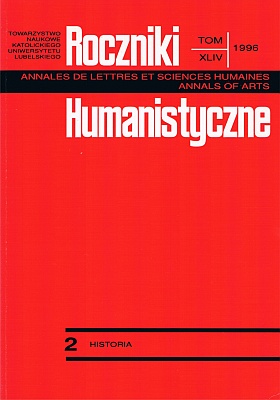Wiara i wyobraźnia. W poszukiwaniu źródeł współczesnego kryzysu obrazowania wiary
Abstract
Among many warning lights of crisis which, contemporary culture is frequently charged with, the crisis of art as a pictural expression of faith went through the official announcement of the Church. The most dramatic speech on this subject was delivered by the pope Paul VI in the 'sixties. The causes of the crisis, however, are complicated and manifold, and they are not to be reduced to any single agent.
The author of the paper points out a particular factor to be taken into account when the history of doctrines − philosophical as well as theological ones − are under enquiry. The doctrinal development was strongly influenced by the standpoint of the ecclesiastical officials prescribing the principles, rules and conditions which had to be observed by the artists and their works in order to be admitted to the sanctuaries and to participate in the acts of cult. The author is of the opinion that the important cause of the contemporary crisis of art functioning in the space of cult has its roots in some time-honawed stereotypes that prevailed over Latin ecclesiastical mentality since the Middle Ages. This was an epoch when the significant and long-standing polarization of the doctrinal viewpoints concerning art between Christian East and West came into action. Byzantine theologians in the train of the iconoclastic controversy had worked out a mature doctrine of the image-worship that was accepted as the „triumph of Orthodoxy” by the Second Nicene Council (787). They interpreted sacred images in terms of the sacraments, as the means of initiation into the mysteries of faith and the visual symbolic celebration of the mystic presence of the Holy. „The art became inseparable from theology” (John Meyendorff). The Latin Church charged the ecclesiastical art with cautious, pragmatic precepts reducing its functions to the didactic, illustrating and decorative aims. The Libri Carolini (794) named the main role the sacred art was to play „the Scripture for illiterates” (biblia pauperum) warning against worshipping the images for fear of idolatry. The art wasn't mentioned even as a „maid servant of theology”.
This western doctrinal reductionism doesn't bring about crisis at once. The baroque art was still able to express fervently the living faith and nourish the taste of believers with imaginary force and sense of holiness. The crisis − the separation of artistic claims and demands of ecclesiastical sponsors − revealed itself during the 19th century. Art proclaimed autonomy (l'art pour l'art) and the Church settled for the artistic production orthodox as to the content but eclectic, second-rate, average and styleless. Thus began an invasion of a daub the sacred places.
Did this situation result from the priority assigned to a word − spoken and written − so typical of western mentality? Or due to the peculiar pragmatism and ingrained prejudice that make Latins believe art to be inferior to the contemplative actions and set it up in the rank of serviceable means void of any dignity? Or, as the case may be, the restrictive legalism fed, the settled doubt and reserve toward the famous disobedience of human faculty producing images, or even more of this, the developing sensualism, naturalism and hedonism of modern esthetics strenghten this retreat from the sacred symbolism and sterilized art from the sense of holiness? No one can give easy answer to these questions.
The Second Vatican Council became the first foreboding of the real change of mind at least. The Constitution of Liturgy with respect to sacred art returns to the forgotten ideas and statements of the Second Nicene Council. The Constitution defines the works of sacred art as „signs and symbols of the supreme reality” and artistic creativity as „the holy imitation of God the Creator”. Using the concept of symbol in the context of liturgical action seems to be the most important issue.
This doesn't mean, of course, that the documents of the Council present a mature theological doctrine of art. This doctrine is still to be worked out. The concept of symbol is in itself very ambiguous. Moreover, no less difficult is the question of the dialogue between modern (or „postmodern”) art and the Church; between artists, fond of their freedom and right to experiment and contest, and the ecclesiastical sponsor caring of the purity of sanctuaries and of the faith of believers.
It must be said frankly that contemporary artistic communities are settled aside the sacred space and places. They are not accustomed with the religious and ecclesiastical demands of cult, worship, liturgy, or sensitivity at all. But they are also in search of some kind of mystery, solemnity, ritual gestures and performances. And often they find all of this in any possible form of deviation, even of a blasphemy. On the other hand, we can observe the warning benality wearing, strumming of liturgy itself. Both symptoms of crisis are a challenge to Christian culture. And both point to the „lost paradigm” of the religious creative imagination which cannot find the appropriate forms of self-expression − in art and in liturgy as well.
The remedy to this situation lays not in the healing of doctrine alone. The most urging need is „to let the artists enter into the sacred places” − as Paul VI put it − let them learn how to become full-fledged participants in the holy mysteries, how to organize the space and time of cult.
Copyright (c) 1996 Roczniki Humanistyczne

This work is licensed under a Creative Commons Attribution-NonCommercial-NoDerivatives 4.0 International License.





